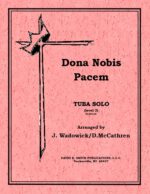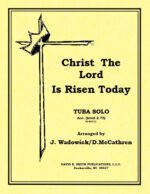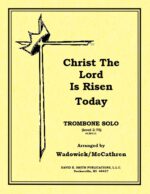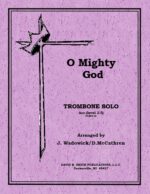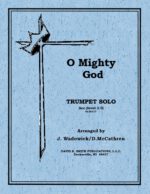-
Dona Nobis Pacem
$4.50This tuba solo begins with a brief motif in the piano and then begins a series of variations and the soloist presents the theme. The variations are sometimes florid, other times plaintive, some times imitative and finally bold.
-
Christ The Lord Is Risen
$5.50A brass solo in a Theme and Variation form. It starts out with a joyous introduction and then breaks into an antiphonal set of response of the tune. The first variation is essentially a descant while the piano carries the tune. The second variation is more contrapuntal in the piano while the solo carries on a fanfare-like obbligato. After a brief transition the piece concludes with a bold statement of the tune while being under-pinned with a walking bass line.
-
O Mighty God
$4.50After a majestic introduction the piece settles down into a softer and more expressive rendition of the tune “How Great Thou Art.” The middle section is a variation of the first section with the melody in the piano while the soloist plays an obbligato styled line. Then the piano present a transition in a majestic style modulating to a new key with the solo line presenting the tune in again expressive style with a lot of dynamic shading. The piece concludes in a majestic sense of finality.
-
Dona Nobis Pacem
$4.50This trombone solo begins with a brief motif in the piano and then begins a series of variations and the soloist presents the theme. The variations are sometimes florid, other times plaintive, some times imitative and finally bold.
-
Christ The Lord Is Risen
$5.50A brass solo in a Theme and Variation form. It starts out with a joyous introduction and then breaks into an antiphonal set of response of the tune. The first variation is essentially a descant while the piano carries the tune. The second variation is more contrapuntal in the piano while the solo carries on a fanfare-like obbligato. After a brief transition the piece concludes with a bold statement of the tune while being under-pinned with a walking bass line.
-
O Mighty God
$4.50After a majestic introduction the piece settles down into a softer and more expressive rendition of the tune “How Great Thou Art.” The middle section is a variation of the first section with the melody in the piano while the soloist plays an obbligato styled line. Then the piano present a transition in a majestic style modulating to a new key with the solo line presenting the tune in again expressive style with a lot of dynamic shading. The piece concludes in a majestic sense of finality.
-
Dona Nobis Pacem
$4.50This trumpet solo begins with a brief motif in the piano and then begins a series of variations and the soloist presents the theme. The variations are sometimes florid, other times plaintive, some times imitative and finally bold.
-
Christ The Lord Is Risen
$5.50A brass solo in a Theme and Variation form. It starts out with a joyous introduction and then breaks into an antiphonal set of response of the tune. The first variation is essentially a descant while the piano carries the tune. The second variation is more contrapuntal in the piano while the solo carries on a fanfare-like obbligato. After a brief transition the piece concludes with a bold statement of the tune while being under-pinned with a walking bass line.
-
O Mighty God
$4.50After a majestic introduction the piece settles down into a softer and more expressive rendition of the tune “How Great Thou Art.” The middle section is a variation of the first section with the melody in the piano while the soloist plays an obbligato styled line. Then the piano present a transition in a majestic style modulating to a new key with the solo line presenting the tune in again expressive style with a lot of dynamic shading. The piece concludes in a majestic sense of finality.

